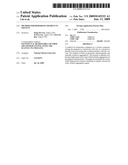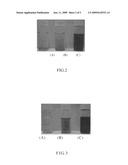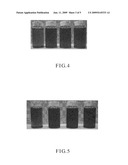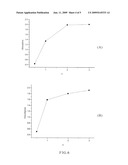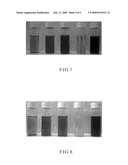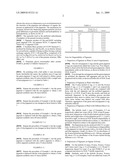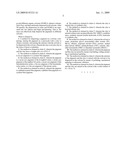Patent application title: Method for dispersing pigment in solvent
Inventors:
Jiang-Jen Lin (Taipei, TW)
Yi-Fen Lan (Taipei, TW)
Yen-Chi Hsu (Taipei, TW)
Yen-Chi Hsu (Taipei, TW)
IPC8 Class: AC09D1102FI
USPC Class:
106487
Class name: Aluminum compound containing, e.g., feldspar, mullite, etc. clay or material derived therefrom containing organic material containing
Publication date: 2009-06-11
Patent application number: 20090145333
pigment in a solvent comprises mixing the
pigment in a nanoscale with clay in a layered or platelet form and mixing
the resultant mixture with the solvent. The method is based on geometric
inhomogeneity and mutually exclusive aggregation. The layered or platelet
clay having a high aspect ratio is provided to hinder aggregation of the
pigment nanoparticles. The pigment nanoparticles can be stably dispersed
in a matrix containing an organic solvent and water without aggregation
again.Claims:
1. A method for dispersing a pigment in a solvent, comprising: mixing the
pigment in a nanoscale with a clay to obtain a mixture, and mixing the
mixture with the solvent to be dispersed in the solvent, wherein the clay
is an ionic clay in the form of layers or platelets.
2. The method as claimed in claim 1, wherein the pigment and the clay have a weight ratio (α) of 0.3.about.5.
3. The method as claimed in claim 1, wherein the pigment is an azo pigment or a cyanine blue pigment.
4. The method as claimed in claim 1, wherein the pigment is a mono-azo pigment of the β-naphtol series, a mono-azo pigment of the naphtol AS series, a mono-azo pigment of the benzimidazolon series, a bis-azo pigment of the benzimidazolon series, or a bis-azo pigment of the ketone series.
5. The method as claimed in claim 1, wherein the pigment is a phthalocyanine blue pigment, a phthalo blue pigment or a cyanine blue pigment.
6. The method as claimed in claim 1, wherein the clay is natural clay or synthetic clay.
7. The method as claimed in claim 1, wherein the clay is layered silicate clay.
8. The method as claimed in claim 7, wherein the clay is natural sodium ionic montmorillonite (Na+-MMT), synthetic mica, synthetic layered double hydroxide (LDH), bentonite or synthetic clay.
9. The method as claimed in claim 1, wherein the solvent is water, propylene glycol monomethyl ether acetate (PGMEA), ethanol, isopropyl alcohol (IPA), acetone, methyl ethyl ketone (MEK), tetrahydrofuran (THF), toluene, dimethyl formamide (DMF) or dimethyl aceamide (DMAC).
10. The method as claimed in claim 1, wherein the pigment and the clay are mixed by means of polishing, rolling, pounding or mechanical agitating.
11. The method as claimed in claim 1, wherein the mixture of the pigment and the clay is mixed with the solvent to be dispersed in the solvent by means of polishing, mechanical agitating or ultrasonic vibration.
12. The method as claimed in claim 1, wherein the pigment and the clay are mixed in the solvent with a solid content of 0.1.about.10 wt. %.Description:
BACKGROUND OF THE INVENTION
[0001]1. Field of the Invention
[0002]The present invention relates to a method for dispersing a pigment in a solvent, which is suitable for applications to color filter, RGB pigment paste, inject ink, display, printing on paper, painting on vehicles or furniture, etc.
[0003]2. Description of the Prior Art
[0004]Most pigments are rigid conjugated-small molecules. Such molecules are usually hard to disperse due to van der Waals force and π-π stacking. Therefore, it's a common issue in applications of pigments how to stably and uniformly disperse the pigments in solvents. Currently, two major solutions are:
(a) Modifying Surface Properties of the Pigments
[0005]Through a chemical process, pigment particles can be modified by grafting specific molecules on surfaces of the pigment particles. Such molecules generally have good affinity to solvents, whereby attraction between the pigment particles can be reduced. Thus the modified pigment particles can perform better in terms of dispersibility, paintability, miscibility with the solvent, etc. However, such modification process occurring between a solid phase and a liquid phase normally requires longer reaction time and has a lower conversion rate, which does not facilitate commercialization.
(b) Adding a Dispersant
[0006]By adding a dispersant in a proper solvent accompanied with mechanical agitating, coagulated pigment particles can be re-dispersed in the solvent. Different from the above modification process involving covalent bonding, only van der Waals force occurs between the dispersant and the pigment particles. Therefore, it's important but difficult to design a proper dispersant depending on the solvent system and surface features of the pigment particles, when considering the balance between particle-particle interaction and particle-solvent interaction. Such dispersant has to be easily adsorbed on surfaces of the pigment particles for them to be well dispersed.
[0007]To improve the above disadvantages, the present invention provides a physical method for dispersing a pigment in a solvent, in which layered or platelet clay is used to separate the pigment particles due to their geometric inhomogeneity or mutually exclusive aggregation.
SUMMARY OF THE INVENTION
[0008]An object of the present invention is to provide a simple method for dispersing a pigment in a solvent without complicated surface modification aforementioned.
[0009]Another object of the present invention is to provide a method for dispersing a pigment in a solvent, so that the pigment can be stably dispersed in a hydrophilic or hydrophobic solvent.
[0010]A further object of the present invention is to provide a method for dispersing a pigment in a solvent, whereby original structure of the pigment can be maintained in the dispersion without destruction.
[0011]To achieve the above objects, the method of the present invention comprises mixing a pigment in a nanoscale with a clay to obtain a mixture and mixing the resultant mixture in a solvent, wherein the clay is an ionic clay in the form of layers or platelets.
[0012]Preferably, the pigment and the clay have a weight ratio (a) of about 0.3˜5.
[0013]In the present invention, the pigment is not limited to any particular type and can be an azo pigment, a cyanine pigment or any other proper pigment. For example, a mono-azo pigment of the β-naphtol series, a mono-azo pigment of the naphtol AS series, a mono-azo pigment of the benzimidazolon series, a bis-azo pigment of the benzimidazolon series, a bis-azo pigment of the ketone series, phthalocyanine blue, phthalo blue or cyanine blue pigment.
[0014]The above clay can be a natural or a synthetic clay, for example, layered silicate clay such as natural sodium ionic montmorillonite (Na+-MMT), synthetic mica, synthetic layered double hydroxide (LDH), bentonite and other synthetic silicates.
[0015]The abovementioned solvent is preferably propylene glycol monomethyl ether acetate (PGMEA), ethanol, isopropyl alcohol (IPA), acetone, methyl ethyl ketone (MEK), tetrahydrofuran (THF), toluene, dimethy formamide (DMF) or dimethyl acetamide (DMAC).
[0016]In the present invention, the pigment and the clay can be mixed by means of polishing, rolling, pounding, mechanical agitating or any other proper mechanism. The pigment and the clay can be dispersed in the solvent by means of polishing, mechanical agitating, ultrasonic vibration or any other proper mechanism. In the solvent, the pigment and the clay preferably have a solid content of about 0.1˜10 wt. %.
BRIEF DESCRIPTION OF THE DRAWINGS
[0017]The patent or application file contains at least one drawing executed in color. Copies of this patent or patent publication with color drawings will be provided by the Office upon request and payment of the necessary fee.
[0018]FIG. 1 shows the mechanism for dispersing the pigment particles with inorganic layered clay.
[0019]FIG. 2 compares dispersibility of the green pigment in water, wherein (A) shows the unpolished pigment, (B) shows the polished pigment, and (C) shows the polished pigment accompanied with a dispersant of the present application.
[0020]FIG. 3 compares dispersibility of the red pigment in water, wherein (A) shows the unpolished pigment, (B) shows the polished pigment, and (C) shows the polished pigment accompanied with a dispersant of the present application.
[0021]FIG. 4 shows dispersions of the hybrids including blue pigment and different amounts of mica in water.
[0022]FIG. 5 shows dispersions of the hybrids including red pigment and different amounts of mica in water.
[0023]FIG. 6 shows the relationship between the weight ratios of mica/pigment (α) and the UV-vis absorbance.
[0024]FIG. 7 shows dispersions of the hybrids including mica and different pigments in water.
[0025]FIG. 8 shows dispersions of the hybrids including mica and different pigments in PGMEA.
DETAILED DESCRIPTION OF THE PREFERRED EMBODIMENTS
[0026]In the present invention, a physical dispersion process for dispersing pigments is applied according to geometric differences of the materials, in which inorganic layered silicate clay serves as a dispersant so as to avoid destruction to the structure of the pigments and influences of organic dispersant on applications of the pigments. The mechanism for inorganic layered clay dispersing pigment particles involves great differences in geometric features and hydrophilicity or hydrophobicity, as shown in FIG. 1.
[0027]The materials used in the preferred embodiments (Examples) of the present invention include:
[0028]1. Pigments: product of Ciba and BASF, including green pigment G36, red pigment R254, CI pigment blue, Yellow 83, CI pigment Violet.
[0029]2. Synthetic Mica: product of CO-OP Chemical Co., produced by heating talc and Na2SiF6 in an electric furnace for several hours, capable of being swollen, having a cationic exchange capacity (CEC) 120 meq/100 g, comprised of Si (26.5 wt %), Mg (25.6 wt %), Al (0.2 wt %), Na (4.1 wt %), Fe (0.1 wt %), F (8.8 wt %), size of the primary structure=300×300×1 nm.
[0030]3. Propylene glycol monomethyl ether acetate: PGMEA, product of Aldrich Chemical Co.
EXAMPLE 1
[0031]By polishing with a ball miller (1 mm zirconium beads, hereinafter the same), the synthetic mica (3 mg) and the green pigment (3 mg) are well mixed to obtain a green pigment-synthetic mica (G-mica) hybrid with a weight ratio of mica/pigment (α)=1, as listed in Table 1.
EXAMPLE 2
[0032]Repeat the procedure of Example 1, but the green pigment is replaced with the red pigment to obtain a red pigment-synthetic mica (R-mica) hybrid.
EXAMPLES 3˜5
[0033]Repeat the procedure of Example 2, but the weight ratio of clay/pigment (α) are changed as those listed in Table 1.
EXAMPLE 6
[0034]Repeat the procedure of Example 1, but the green pigment is replaced with the blue pigment to obtain a blue pigment-synthetic mica (B-mica) hybrid.
EXAMPLES 7˜9
[0035]Repeat the procedure of Example 6, but the weight ratio of clay/pigment (α) are changed as those listed in Table 1.
EXAMPLE 10
[0036]Repeat the procedure of Example 1, but the green pigment is replaced with the yellow pigment to obtain a yellow pigment-synthetic mica (Y-mica) hybrid.
EXAMPLE 11
[0037]Repeat the procedure of Example 1, but the green pigment is replaced with the violet pigment to obtain a violet pigment-synthetic mica (V-mica) hybrid.
TABLE-US-00001 TABLE 1 Weight ratio of Example Pigment clay/pigment (α) Hybrid 1 green 1.0 G-mica 2 red 1.0 R-mica 3 red 0.5 R-mica 4 red 2.0 R-mica 5 red 3.0 R-mica 6 blue 1.0 B-mica 7 blue 0.5 B-mica 8 blue 2.0 B-mica 9 blue 3.0 B-mica 10 yellow 1.0 Y-mica 11 violet 1.0 V-mica
Tests for Dispersibility of Pigments
1. Dispersion of Pigments in Water (Control Experiments)
[0038]The raw red pigment (1 mg) and the green pigment (1 mg) are respectively added into water (5 g). Poor dispersibility is observed for the both red and green pigments, which immediately settle on the bottom, as shown in bottles (A) of FIGS. 2 and 3.
[0039]Even though the red pigment and the green pigment are polished, the pigments still aggregate and can not be dispersed well in water, as shown in bottles (B) of FIGS. 2 and 3.
2. Dispersion of Pigments in Water with Mica
[0040]The G-mica hybrid (2 mg, α=1) and the R-mica hybrid (2 mg, α=1) of Examples 1 and 2 are respectively added into water (5 g), and the results are compared with those with the raw pigments and the polished pigments. Bottles (C) of FIGS. 2 and 3 show the results, and both are uniformly dispersed. As the polishing process provides mechanical shear stress to reduce sizes of the pigment particles, more surface area thereof can contact with mica. Therefore, aggregation of the green and red pigments is significantly reduced.
3. Dispersion of Pigments in Water with Different Mica Content
[0041]The hybrids (each 1 mg) of Examples 2˜9 are respectively added into water (20 g). FIGS. 4 and 5 respectively show dispersions of the B-mica hybrid and the R-mica hybrid, and weight ratios of mica/pigment are 0.5, 1, 2 and 3, from left to right. As shown in FIGS. 4 and 5, dispersibility of the pigments increases with the mica content, i.e., the effect of geometric dispersion relates to the pigment/mica ratio.
[0042]The dispersions are also analyzed with UV-vis spectrum. As shown in FIG. 6, UV-vis absorbance or dispersibility of the pigment in water increases with α, for both of the red and blue pigments. Graph (A) shows UV-vis absorbance of the B-mica hybrid having different α at λ=360 nm; and graph (B) shows UV-vis absorbance of the R-mica hybrid having different α at λ=565 nm.
4. Dispersions of Pigments in Organic Solvents
[0043]For the hybrids (G-mica, R-mica, B-mica, Y-mica and V-mica; each 1 mg, α=1) of Examples 1, 2, 6, 10 and 11, dispersions thereof in water (5 g) and PGMEA (5 g) are compared and shown in FIGS. 7 and 8, respectively.
[0044]Similarly, each of the hybrids (R-mica, B-mica; each 1 mg, α=1) of Examples 2 and 6 are added into water (10 g) and different organic solvents (PGMEA, ethanol, toluene; each 10 g), and then uniformly dispersed in all solvents. After 30 minutes, the dispersions in water and PGMEA are separated into two phases and begin precipitating. That is, the mica can effectively help disperse the pigments in different solvents.
Claims:
1. A method for dispersing a pigment in a solvent, comprising: mixing the
pigment in a nanoscale with a clay to obtain a mixture, and mixing the
mixture with the solvent to be dispersed in the solvent, wherein the clay
is an ionic clay in the form of layers or platelets.
2. The method as claimed in claim 1, wherein the pigment and the clay have a weight ratio (α) of 0.3.about.5.
3. The method as claimed in claim 1, wherein the pigment is an azo pigment or a cyanine blue pigment.
4. The method as claimed in claim 1, wherein the pigment is a mono-azo pigment of the β-naphtol series, a mono-azo pigment of the naphtol AS series, a mono-azo pigment of the benzimidazolon series, a bis-azo pigment of the benzimidazolon series, or a bis-azo pigment of the ketone series.
5. The method as claimed in claim 1, wherein the pigment is a phthalocyanine blue pigment, a phthalo blue pigment or a cyanine blue pigment.
6. The method as claimed in claim 1, wherein the clay is natural clay or synthetic clay.
7. The method as claimed in claim 1, wherein the clay is layered silicate clay.
8. The method as claimed in claim 7, wherein the clay is natural sodium ionic montmorillonite (Na+-MMT), synthetic mica, synthetic layered double hydroxide (LDH), bentonite or synthetic clay.
9. The method as claimed in claim 1, wherein the solvent is water, propylene glycol monomethyl ether acetate (PGMEA), ethanol, isopropyl alcohol (IPA), acetone, methyl ethyl ketone (MEK), tetrahydrofuran (THF), toluene, dimethyl formamide (DMF) or dimethyl aceamide (DMAC).
10. The method as claimed in claim 1, wherein the pigment and the clay are mixed by means of polishing, rolling, pounding or mechanical agitating.
11. The method as claimed in claim 1, wherein the mixture of the pigment and the clay is mixed with the solvent to be dispersed in the solvent by means of polishing, mechanical agitating or ultrasonic vibration.
12. The method as claimed in claim 1, wherein the pigment and the clay are mixed in the solvent with a solid content of 0.1.about.10 wt. %.
Description:
BACKGROUND OF THE INVENTION
[0001]1. Field of the Invention
[0002]The present invention relates to a method for dispersing a pigment in a solvent, which is suitable for applications to color filter, RGB pigment paste, inject ink, display, printing on paper, painting on vehicles or furniture, etc.
[0003]2. Description of the Prior Art
[0004]Most pigments are rigid conjugated-small molecules. Such molecules are usually hard to disperse due to van der Waals force and π-π stacking. Therefore, it's a common issue in applications of pigments how to stably and uniformly disperse the pigments in solvents. Currently, two major solutions are:
(a) Modifying Surface Properties of the Pigments
[0005]Through a chemical process, pigment particles can be modified by grafting specific molecules on surfaces of the pigment particles. Such molecules generally have good affinity to solvents, whereby attraction between the pigment particles can be reduced. Thus the modified pigment particles can perform better in terms of dispersibility, paintability, miscibility with the solvent, etc. However, such modification process occurring between a solid phase and a liquid phase normally requires longer reaction time and has a lower conversion rate, which does not facilitate commercialization.
(b) Adding a Dispersant
[0006]By adding a dispersant in a proper solvent accompanied with mechanical agitating, coagulated pigment particles can be re-dispersed in the solvent. Different from the above modification process involving covalent bonding, only van der Waals force occurs between the dispersant and the pigment particles. Therefore, it's important but difficult to design a proper dispersant depending on the solvent system and surface features of the pigment particles, when considering the balance between particle-particle interaction and particle-solvent interaction. Such dispersant has to be easily adsorbed on surfaces of the pigment particles for them to be well dispersed.
[0007]To improve the above disadvantages, the present invention provides a physical method for dispersing a pigment in a solvent, in which layered or platelet clay is used to separate the pigment particles due to their geometric inhomogeneity or mutually exclusive aggregation.
SUMMARY OF THE INVENTION
[0008]An object of the present invention is to provide a simple method for dispersing a pigment in a solvent without complicated surface modification aforementioned.
[0009]Another object of the present invention is to provide a method for dispersing a pigment in a solvent, so that the pigment can be stably dispersed in a hydrophilic or hydrophobic solvent.
[0010]A further object of the present invention is to provide a method for dispersing a pigment in a solvent, whereby original structure of the pigment can be maintained in the dispersion without destruction.
[0011]To achieve the above objects, the method of the present invention comprises mixing a pigment in a nanoscale with a clay to obtain a mixture and mixing the resultant mixture in a solvent, wherein the clay is an ionic clay in the form of layers or platelets.
[0012]Preferably, the pigment and the clay have a weight ratio (a) of about 0.3˜5.
[0013]In the present invention, the pigment is not limited to any particular type and can be an azo pigment, a cyanine pigment or any other proper pigment. For example, a mono-azo pigment of the β-naphtol series, a mono-azo pigment of the naphtol AS series, a mono-azo pigment of the benzimidazolon series, a bis-azo pigment of the benzimidazolon series, a bis-azo pigment of the ketone series, phthalocyanine blue, phthalo blue or cyanine blue pigment.
[0014]The above clay can be a natural or a synthetic clay, for example, layered silicate clay such as natural sodium ionic montmorillonite (Na+-MMT), synthetic mica, synthetic layered double hydroxide (LDH), bentonite and other synthetic silicates.
[0015]The abovementioned solvent is preferably propylene glycol monomethyl ether acetate (PGMEA), ethanol, isopropyl alcohol (IPA), acetone, methyl ethyl ketone (MEK), tetrahydrofuran (THF), toluene, dimethy formamide (DMF) or dimethyl acetamide (DMAC).
[0016]In the present invention, the pigment and the clay can be mixed by means of polishing, rolling, pounding, mechanical agitating or any other proper mechanism. The pigment and the clay can be dispersed in the solvent by means of polishing, mechanical agitating, ultrasonic vibration or any other proper mechanism. In the solvent, the pigment and the clay preferably have a solid content of about 0.1˜10 wt. %.
BRIEF DESCRIPTION OF THE DRAWINGS
[0017]The patent or application file contains at least one drawing executed in color. Copies of this patent or patent publication with color drawings will be provided by the Office upon request and payment of the necessary fee.
[0018]FIG. 1 shows the mechanism for dispersing the pigment particles with inorganic layered clay.
[0019]FIG. 2 compares dispersibility of the green pigment in water, wherein (A) shows the unpolished pigment, (B) shows the polished pigment, and (C) shows the polished pigment accompanied with a dispersant of the present application.
[0020]FIG. 3 compares dispersibility of the red pigment in water, wherein (A) shows the unpolished pigment, (B) shows the polished pigment, and (C) shows the polished pigment accompanied with a dispersant of the present application.
[0021]FIG. 4 shows dispersions of the hybrids including blue pigment and different amounts of mica in water.
[0022]FIG. 5 shows dispersions of the hybrids including red pigment and different amounts of mica in water.
[0023]FIG. 6 shows the relationship between the weight ratios of mica/pigment (α) and the UV-vis absorbance.
[0024]FIG. 7 shows dispersions of the hybrids including mica and different pigments in water.
[0025]FIG. 8 shows dispersions of the hybrids including mica and different pigments in PGMEA.
DETAILED DESCRIPTION OF THE PREFERRED EMBODIMENTS
[0026]In the present invention, a physical dispersion process for dispersing pigments is applied according to geometric differences of the materials, in which inorganic layered silicate clay serves as a dispersant so as to avoid destruction to the structure of the pigments and influences of organic dispersant on applications of the pigments. The mechanism for inorganic layered clay dispersing pigment particles involves great differences in geometric features and hydrophilicity or hydrophobicity, as shown in FIG. 1.
[0027]The materials used in the preferred embodiments (Examples) of the present invention include:
[0028]1. Pigments: product of Ciba and BASF, including green pigment G36, red pigment R254, CI pigment blue, Yellow 83, CI pigment Violet.
[0029]2. Synthetic Mica: product of CO-OP Chemical Co., produced by heating talc and Na2SiF6 in an electric furnace for several hours, capable of being swollen, having a cationic exchange capacity (CEC) 120 meq/100 g, comprised of Si (26.5 wt %), Mg (25.6 wt %), Al (0.2 wt %), Na (4.1 wt %), Fe (0.1 wt %), F (8.8 wt %), size of the primary structure=300×300×1 nm.
[0030]3. Propylene glycol monomethyl ether acetate: PGMEA, product of Aldrich Chemical Co.
EXAMPLE 1
[0031]By polishing with a ball miller (1 mm zirconium beads, hereinafter the same), the synthetic mica (3 mg) and the green pigment (3 mg) are well mixed to obtain a green pigment-synthetic mica (G-mica) hybrid with a weight ratio of mica/pigment (α)=1, as listed in Table 1.
EXAMPLE 2
[0032]Repeat the procedure of Example 1, but the green pigment is replaced with the red pigment to obtain a red pigment-synthetic mica (R-mica) hybrid.
EXAMPLES 3˜5
[0033]Repeat the procedure of Example 2, but the weight ratio of clay/pigment (α) are changed as those listed in Table 1.
EXAMPLE 6
[0034]Repeat the procedure of Example 1, but the green pigment is replaced with the blue pigment to obtain a blue pigment-synthetic mica (B-mica) hybrid.
EXAMPLES 7˜9
[0035]Repeat the procedure of Example 6, but the weight ratio of clay/pigment (α) are changed as those listed in Table 1.
EXAMPLE 10
[0036]Repeat the procedure of Example 1, but the green pigment is replaced with the yellow pigment to obtain a yellow pigment-synthetic mica (Y-mica) hybrid.
EXAMPLE 11
[0037]Repeat the procedure of Example 1, but the green pigment is replaced with the violet pigment to obtain a violet pigment-synthetic mica (V-mica) hybrid.
TABLE-US-00001 TABLE 1 Weight ratio of Example Pigment clay/pigment (α) Hybrid 1 green 1.0 G-mica 2 red 1.0 R-mica 3 red 0.5 R-mica 4 red 2.0 R-mica 5 red 3.0 R-mica 6 blue 1.0 B-mica 7 blue 0.5 B-mica 8 blue 2.0 B-mica 9 blue 3.0 B-mica 10 yellow 1.0 Y-mica 11 violet 1.0 V-mica
Tests for Dispersibility of Pigments
1. Dispersion of Pigments in Water (Control Experiments)
[0038]The raw red pigment (1 mg) and the green pigment (1 mg) are respectively added into water (5 g). Poor dispersibility is observed for the both red and green pigments, which immediately settle on the bottom, as shown in bottles (A) of FIGS. 2 and 3.
[0039]Even though the red pigment and the green pigment are polished, the pigments still aggregate and can not be dispersed well in water, as shown in bottles (B) of FIGS. 2 and 3.
2. Dispersion of Pigments in Water with Mica
[0040]The G-mica hybrid (2 mg, α=1) and the R-mica hybrid (2 mg, α=1) of Examples 1 and 2 are respectively added into water (5 g), and the results are compared with those with the raw pigments and the polished pigments. Bottles (C) of FIGS. 2 and 3 show the results, and both are uniformly dispersed. As the polishing process provides mechanical shear stress to reduce sizes of the pigment particles, more surface area thereof can contact with mica. Therefore, aggregation of the green and red pigments is significantly reduced.
3. Dispersion of Pigments in Water with Different Mica Content
[0041]The hybrids (each 1 mg) of Examples 2˜9 are respectively added into water (20 g). FIGS. 4 and 5 respectively show dispersions of the B-mica hybrid and the R-mica hybrid, and weight ratios of mica/pigment are 0.5, 1, 2 and 3, from left to right. As shown in FIGS. 4 and 5, dispersibility of the pigments increases with the mica content, i.e., the effect of geometric dispersion relates to the pigment/mica ratio.
[0042]The dispersions are also analyzed with UV-vis spectrum. As shown in FIG. 6, UV-vis absorbance or dispersibility of the pigment in water increases with α, for both of the red and blue pigments. Graph (A) shows UV-vis absorbance of the B-mica hybrid having different α at λ=360 nm; and graph (B) shows UV-vis absorbance of the R-mica hybrid having different α at λ=565 nm.
4. Dispersions of Pigments in Organic Solvents
[0043]For the hybrids (G-mica, R-mica, B-mica, Y-mica and V-mica; each 1 mg, α=1) of Examples 1, 2, 6, 10 and 11, dispersions thereof in water (5 g) and PGMEA (5 g) are compared and shown in FIGS. 7 and 8, respectively.
[0044]Similarly, each of the hybrids (R-mica, B-mica; each 1 mg, α=1) of Examples 2 and 6 are added into water (10 g) and different organic solvents (PGMEA, ethanol, toluene; each 10 g), and then uniformly dispersed in all solvents. After 30 minutes, the dispersions in water and PGMEA are separated into two phases and begin precipitating. That is, the mica can effectively help disperse the pigments in different solvents.
User Contributions:
Comment about this patent or add new information about this topic:

